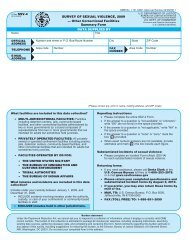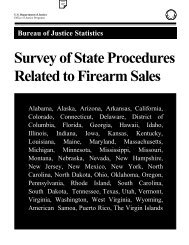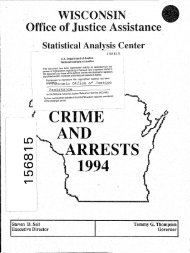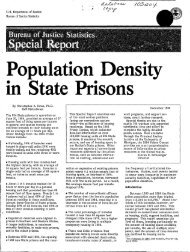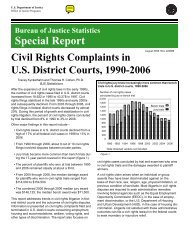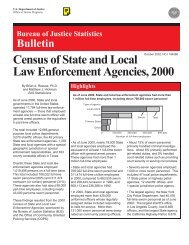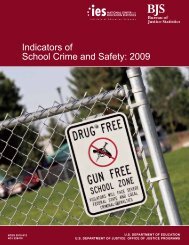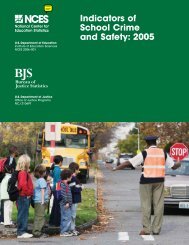Sourcebook of Criminal Justice Statistics, 1983 - Bureau of Justice ...
Sourcebook of Criminal Justice Statistics, 1983 - Bureau of Justice ...
Sourcebook of Criminal Justice Statistics, 1983 - Bureau of Justice ...
Create successful ePaper yourself
Turn your PDF publications into a flip-book with our unique Google optimized e-Paper software.
~~~-------- -, -- -~-~-~-~-~----"'-~------------------------~<strong>Sourcebook</strong> <strong>of</strong> <strong>Criminal</strong> <strong>Justice</strong> <strong>Statistics</strong> <strong>1983</strong>Appendicesbeen developed due to th" wide variotion )~ 1 the coverage <strong>of</strong> variouspions, employee stotus requirements, bene~,t rotes, etc.. ,For !hos: governments whose records reflect contributions for<strong>Criminal</strong> ju~tlce employees separately, separate data were obtained.How~'.er, thes,e data are subject to variation and neither the amountnor, the quality <strong>of</strong>, th~ dota reported would permit any attempt toestimate t?tal contributions for all similar governments in a giVenSta~e. Given the problems involved, no estimation procedure seemedfeaSible. Such data as were reported separately were thereforeexc~lJded from total criminal justice expenditures to provide acons~stent data bose for administering the "variable pass-through"requirement.Expenditure is divided into two major categories by character'I. "D.irect expenditure" is all expenditure except thatclassed as Intergovernmental and is further divided into twoprincipal object categories:(0) "Direct current," which includes salaries, wagesfees, and commissions, purchase or supplies, materials andcontractuol services.'(b) "Capitol outlay," which includes expenditure forthe three subcategories below:(I) "Construction:" Production <strong>of</strong> fixed works andstructures, and additions, replacements and majoralterations thereto undertaken either on a contractbasis by private contractors or through force accountconstruction by the employees <strong>of</strong> the government.Included are the planning and designing <strong>of</strong> specificprojects, the grading, landscaping, and other siteImprOVement, and the provision <strong>of</strong> equipment andfacilities that are integral parts <strong>of</strong> the structure.(2) "Equipment:" Purchase and Installation <strong>of</strong>apparatus, furnishings, <strong>of</strong>fice equipment, motorvehicles, and the like having on expected life <strong>of</strong> morethan 5 years. This Includes both additional equlprnentand repl-lcements. Rentals for eqUipment, inc!udlngrental payments that may be credited on the purchaseprice if purchase options are exercised, are closslfledas current operation expenditure. Equipment andfacIlities that are integral parts <strong>of</strong> constructed orpurcha,~ed structures are classified respectively underconstruction or purchase <strong>of</strong> land and existingstructures.(3) ''Purchase <strong>of</strong> land and existing structureSI"Purchase <strong>of</strong> these assets os such, purchase <strong>of</strong> rights<strong>of</strong>-way,and title search and similar activitiesassociated with purchase transactions.The o!her object categorles--Interest on general debt, osslstanceand subsidies, and insurance beneflts--are not applied to specificfunctions because they are not ordinarIly available on a functional basisfrom government financial reports. In the few Instances where bondedor mortgaged general Indebtedness Is Identified for specific purposesthe Interest payments are aggregated with other Interest expendlture~that make it virtually impossible to arrive at reliable and consistentbreakouts <strong>of</strong> such data over a long period <strong>of</strong> time.2. "Intergovernmental expenditure" Is payments from onegovernme~t t? another, incioJding gronts-In-ald, shared revenues,payments In lieu <strong>of</strong> taxes, and amounts for services performed byone, government for another on a reimbursable or cost-shoringbasIs, (for e,xample, payments by one government to another forboarding prISoners)."Total expenditure" is direct and intergovernmental expenditure<strong>of</strong> a government or level <strong>of</strong> government for criminal justice activities"Total general expenditure" is all expenditure <strong>of</strong> a government 0;!ev~1 <strong>of</strong> go,v~rnment for all ,government functions, including criminal<strong>Justice</strong> ~ctlvlties, but, excluding utility system expenditure, liquor storeexpen~lture, and Insurance trust expenditure. Total generalexpendl!ure shown for the local level <strong>of</strong> government includesexpen?lture only, <strong>of</strong> ~eneral purpose governments, and excludesexpenditure <strong>of</strong> speCial districts and school districts.Government employment--"Employees" includes all persons paidfor pe,rsonal services performed, i.ncluding all paid <strong>of</strong>ficials and personsin paid le'!ve status, and excluaes unpaid <strong>of</strong>ficials, persons on unpaidleave, pensioners and contractors. Under this definition are twoclasses:I. 'f'ull-time employees," who are all persons employedduring the poy period including Oct. 15, 1979, on a full-timebasis, including all full-time temporary or seasonal workersemployed dUring this pay period as well as persons havingpermanent status.• 2. ''Pa.rt-time et;nployees," who are persons employed during.~e pay period Including Oct. 15, 1979, on a basis other than f'JIItime,and persons paid by more than one governmentDerived fram these two closses iSl•"Full-time equivalent employees," which means thetotal ~umber o,f employees, discounted by applying overagefull-time earning rates. This Is colculated by dividing thetotal payroll (full-time plus port-time) by the full-timepayroll and multiplying this by the number <strong>of</strong> full-timeemployees, where both full-time and part-time employeesand payroll are reported. Where only part-time employeesand payroll are r:p?r!ed, full-time equivalent employees arecalCUlated by diViding the total port-time payroll by theaverage full-time salary for the particular crIminal justice~ector and type <strong>of</strong> government, "Average full-time salory"IS calcul~ted by dividing the full-time payroll by the number<strong>of</strong> full -time employees for the porticular criminal justicesector and type <strong>of</strong> government.,"Payroll" is the gross payroll before deductions and Includessalaries, wages, fees, and commissions paid to employees as definedabove for the month <strong>of</strong> October 1979.Governmental functions--''Police protection" is the function <strong>of</strong>e~forclng the law, preserving order, and apprehending those whoViolate the low, w~ether the~e activities are performed by a policedeportment, a sheriff's deportment, or a special police force maintainedby an agency whose prime responsibility is outside the criminal justicesystem .. but that has a ~lice force to perform these activities in itsspecialized area (geographiC or functional)., Included I~ this activity are regular pq,lice services, themaintenance <strong>of</strong> buildings used for police purposes, and such specializedpol,lce forces (including public and private contract forces) as airportpolice, free and toll highway police, free and toli bridge and tunnelpolice, housing police, maritime police, pork police, transit and otherutility system police, college and University campus police andalcoholic beverage control agents. Coroners and medIcal examlne;s arealso included. Excluded ?re vehicular inspection and licensing, traffics,afety and engineering, fish and game wardens, fire marshals and thelike.'The special police forces included in the dot a are only those thatare port <strong>of</strong> general purpose governments. Security forces buIldingguords, school crossing guards, and metermaids without the' power tomake a police arrest were excluded. Those special police forces thatare part <strong>of</strong> Independent school districts or special districts are natincluded In the data, Inasmuch as these districts are not generalpurpose governments.In mast States, sheriffs' deportments are multifUnctional ogenclesproviding police protection, judicial, and/or correctional services. Inorder to allocate expenditure and employment data to the properactivity, the data for sheriffs' departments are prorated using factorsdevelop'~d from a special survey <strong>of</strong> sheriffs' departments conducted In1973, or more current estimates <strong>of</strong> manpower distribution If available.Short-term custody and detention have traditionally beenconsidered part <strong>of</strong> the "police protection" function, and In editionsprior to the 1969-70 report, were treated as such. However beginningwith the 1969-70 report, the concept was modified on the basis <strong>of</strong>Information obtained from the 1970 NationcJ/ Jail Census. Data forInstitutions with authority to hold prisoners 48 hours or more areincluded in the "corrections" sector. Data for lockups or "tanks"holding prisoners less than 48 hours are Included In the "policeprotection" sector."Judicial activities" encompass all courts and activitiesossoclated with courts such as law libraries, grand juries, petit juries,and the like. Because the names <strong>of</strong> courts with similar functions ondlegal jurisdictions vary from State to State and even within Statesdata have been categorized by types <strong>of</strong> court rather than by courtname.I. "Appellate courts" Include courts <strong>of</strong> last resort and!nter":1ediate appellate courts. These are courts haVingJurisdiction <strong>of</strong> appeal and review, with original jurisdictionconferred only In special cases.2. "Courts <strong>of</strong> general jurisdiction" are trial courts <strong>of</strong>general j~ri~dlction having unlimited original jurisdiction In civIland/or criminal cases.In many States, statutes either reqIJire or permit localgovernmen,ts to supplement the salary <strong>of</strong> State-paid judges <strong>of</strong>~neral jUrISdiction courts. These judges were counted as porttimeemployees at both the State and local levels when actuallyreceiving a check from both governments., 3., "Courts <strong>of</strong> limited jurisdiction" are courts whose legaljUrisdiction covers only a particular closs <strong>of</strong> cases or cases Inwhich the amount in controversy Is below a prescribed sum orthat is subject to specific exceptions. Included In this categoryar~ probate courts, juvenile courts, and other courts <strong>of</strong> limitedjUrisdiction.4. "Miscellaneous judicial" Includes data on judicialactivities that could not be reported under any <strong>of</strong> the abovecourt categories, such as Judicial councils and conferellces courtadministration <strong>of</strong>fices (where Identifiable), law IIbrarle~ jurycommissions, and grand juries.'• "Legal, services and prosecution" Includes the civil and criminal<strong>Justice</strong> activities <strong>of</strong> the attorneys general, district attorneys State'satt?rneys and their variously named equivalents; corporation dounsels,so II c,ltors, and lega! departments with various names. It IncludesprOViding legal adVice to the chief executives and subordinatedepartmental <strong>of</strong>ficers, representation <strong>of</strong> the government In lawsuits andthe prosecution <strong>of</strong> accused violators <strong>of</strong> criminal law. These act!~ltlesare Included whether performed by one <strong>of</strong>fice or several, because insome jurisdictions a single <strong>of</strong>fender provides all legal services whlle Inothers a prosecutor's <strong>of</strong>fice handles only orimlnal matt~rs and aseparate attorney's <strong>of</strong>fice performs all civil legal services. Theoperations <strong>of</strong> various Investigative agencies having fullarrest powers and attached to <strong>of</strong>fices <strong>of</strong> attorneys general, distrlctattorneys or their variously named equivalents are also included.''Public defense" includes legal counsel and representation asprovided by public defenders, and other government programs that paythe fees <strong>of</strong> court-appointed counsel. These include court-paid fees t?individually retained counsel, fees paid by the court to court-appointedcounsel, government contributions to private legal aid societies and barassociation-sponsored programs, and the activities <strong>of</strong> on establishedpublic defender <strong>of</strong>fice or program. Employment data are included onlyfor public defenders' <strong>of</strong>fices because fee-paid counselors are notconsidered government employees, nor are counselors working for barassociations or legal aid societies."Corrections" Is that function <strong>of</strong> government involving theconfinement and rehabilitation <strong>of</strong> adUlts and juveniles convicted <strong>of</strong><strong>of</strong>fenses against the law, and the confinement <strong>of</strong> persons suspected <strong>of</strong> acrime and awaiting adjudication. Data for institutions with authorityto hold prisoners 48 hours or more are included in this sector. Datafor lockups or "tanks" holding prisoners less than 48 hours are includedin "police protection." Corrections includes the operation <strong>of</strong> prisons,reformatories, jails, houses <strong>of</strong> correction, and other institutions. Italso includes institutions, facilities, and programs exclusively for theconfinement <strong>of</strong> the criminally insane 01 for the examination, eValuation,clossification, and ossig'1ment <strong>of</strong> inmates; and institutions and programsfor the confinement, treatment, and rehabilitation <strong>of</strong> drug addicts andalcoholics if the institution or program is administered by a correctionagency <strong>of</strong> the criminal justice system. Pardon boards, parole andprobation agencies, including resettlement or halfway houses for thosenot in need <strong>of</strong> institutionalization, ore included in the correction sectoras a separate subcategory.I. "Correctional Institutions" are prisons, reformatories,jalls, houses <strong>of</strong> correction, penitentiaries, correctional farms,work-houses, reception centers, diagnostic centers, industrialschools, training schools, detention centers, and a variety <strong>of</strong>other types <strong>of</strong> institutions for the confinement and correction <strong>of</strong>convicted adults or juveniles adjudicated delinquent and or inneed <strong>of</strong> supervision, and for the detention <strong>of</strong> those accused <strong>of</strong> acrime and awaiting trial or hearing. When an institutionmaintains a prison industry or agricultural program, data on thecost <strong>of</strong> production or the value <strong>of</strong> prison labor used by agencies<strong>of</strong> the same government, if identifiable, are excluded (and classedas expenditure for the function using the products or services).ExpenditIJre for the manufacture, production, sale,' anddistribution <strong>of</strong> goods produced for sale or use outside thegovernment are included under this heading.(a) "Institutions for men" include identifiableexpenditure and employment data for institutions exclusivelyfor adult male <strong>of</strong>fenders.(b) "Institutions for women" include identifiableexpenditure and employment data for institutions exclusivelyfor adult female <strong>of</strong>fenders. Where there is no seporatewomen's prison, women <strong>of</strong>fenders are either maintained In aprison complex that also houses other <strong>of</strong>fenders, or areboarded In private facilities or Institutions in another State.N:> attempt was made to prorate data on Institutions housingmore than one type <strong>of</strong> inmate, but where females areboarded in private institutions or in another State, availableexpenditure data were tabulated. Employment data werenot tabulated because the personnel were employees <strong>of</strong>another government.(c) "Institutions for juveniles" are those institutionsidentified by the 1977 Juvenile Detention and CorrectionalFacility Census as housing primarily juveniles, and in someStates, "youthful <strong>of</strong>fenders." These institutions includethose under the control <strong>of</strong> a juvenile court, a probationdeportment, or a youth authority or other similarlydesignated administrative body, as well as independentlYadministered institutions. Also included are governmentpayments to private agencies for the detention or treatment<strong>of</strong> delinquent juveniles. There is considerable variation fromState to State in the legal definition <strong>of</strong> a juvenile,particularly i" regard to the age at which a person is nolonger considered a juvenile. Institutions for juveniles havebeen classified individually in accordance with the lows andage designations <strong>of</strong> their respective States.(d) "Other and combined institutions" are thoseinstitutions holding a combination <strong>of</strong> inmates, Whereexpenditure or employment data for physically separateinstitutions for juveniles, adult females, and adult maleswere not seporable by institution or type <strong>of</strong> institution, theentire amounts were included under this category.2. "Correctional administration" consists <strong>of</strong> data for theadministration <strong>of</strong> the correctional system, including data on thecentral administrative <strong>of</strong>fice (e.g., the department <strong>of</strong> correctionsor a youth authority). Data an the administration <strong>of</strong> individualcorrectional Institutions or probation/porole/pordon agencies areincluded in the appropriate subcategory if it was possible todeduct them.3. "Probation, parole, and pardon" includes data onprobation agencies, boards <strong>of</strong> porole, boards <strong>of</strong> pardon, and theirvariously named eqUivalents. Although probation agenciesfrequently function under the administration <strong>of</strong> the generaljurisdiction court, the data are presented here after having beendeducted from the judicial data, because <strong>of</strong> the correctionalnature <strong>of</strong> the probotion function. If the probation, parole, andpordon activities, or any <strong>of</strong> them individually, were part <strong>of</strong> thecorrectional administrative <strong>of</strong>fice, data were deducted and shownseparately here, and the balance was shown under thecarrectional administration category. The overlapping character<strong>of</strong> the probation, parole, and pardon activities prevented theseparate presentation <strong>of</strong> these data.4. "Miscellaneous correction" includes expenditure andemployment data which could not be classified under one <strong>of</strong> theother subcategories.''Other criminal justice activities," shawn in some tables, includesexpenditure or employment data that are not clossified elsewhere, orthat cut across more than one category, or that are not allocable toseporate categories (e,g., expenditure on a general curriculum ineducational institutions, the operation <strong>of</strong> State criminal justiceagencies, crime commissions, etc.), Such data are included in thetotals, where they are not shown separately.63B639



